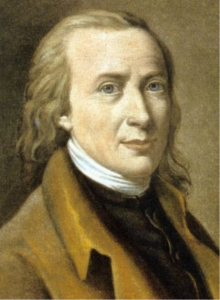To a spring
(Poet's title: An eine Quelle)
Set by Schubert:
D 530
[February 1817]
Du kleine grünumwachsne Quelle,
An der ich Daphne jüngst gesehn,
Dein Wasser war so still! und helle!
Und Daphnes Bild darin so schön!
Oh, wenn sie sich noch mahl am Ufer sehen lässt,
So halte du ihr schönes Bild doch fest;
Ich schleiche heimlich dann mit naßen Augen hin,
Dem Bild meine Not zu klagen;
Denn, wenn ich bei ihr selber bin,
Dann, ach, dann kann ich ihr nichts sagen.
You small spring, grown over with vegetation,
By which I recently saw Daphne!
Your water was so silent! so bright!
And Daphne’s image within it, so beautiful!
Oh, if she lets herself be seen once more on the bank
Just hold on tight to her image;
I shall then creep up secretly with watery eyes
To lament my fate by that image;
Because, when I am in her actual presence
Then, oh, then I am unable to say anything to her.
All translations into English that appear on this website, unless otherwise stated, are by Malcolm Wren. You are free to use them on condition that you acknowledge Malcolm Wren as the translator and schubertsong.uk as the source. Unless otherwise stated, the comments and essays that appear after the texts and translations are by Malcolm Wren and are © Copyright.
☙
Themes and images in this text:
Appearance and reality By water – river banks Eyes Green Laments, elegies and mourning Noise and silence Pictures and paintings Springs, sources and fountains Surface of the water Tears and crying Wet and dry
She almost certainly was not called Daphne, and the speaker’s inability to speak to her directly may have nothing to do with a lack of confidence. It is more likely all connected with the social conventions which kept them apart. She will have been raised in a strict environment which discourages young women from making eye contact with young men; similarly, he cannot say anything much to her without having to ‘declare his intentions’. If he is not in a position to offer marriage (usually because of a lack of funds or social status) he should say as little as possible in her presence.
All of this probably explains why she looked down into the clear water by the spring when they met. This allowed him his only unhindered view of her face, but in the form of a reflection, a fleeting image. If only this image could be fixed he would be in a position to speak to her properly. Even then, he would be in no position to declare his passion, he would only be able to lament the situation. As it is, he is reduced to speaking to the pool of water where he once glimpsed a reflection of her face.
☙
Original Spelling
An eine Quelle
Du kleine grünumwachsne Quelle,
An der ich Daphne jüngst gesehn!
Dein Wasser war so still! so helle!
Und Daphne's Bild darin, so schön!
O, wenn sie sich noch mahl am Ufer sehen läßt,
So halte du ihr schönes Bild doch fest;
Ich schleiche heimlich denn mit naßen Augen hin,
Dem Bilde meine Noth zu klagen;
Denn, wenn ich bey ihr selber bin,
Denn, ach! denn kann ich ihr nichts sagen.
Confirmed by Peter Rastl with Schubert’s probable source, ASMUS omnia sua SECUM portans, oder Sämmtliche Werke des Wandsbecker Bothen, I. und II. Theil. Beym Verfasser, und in Commißion bey Fr. Perthes in Hamburg. [1774], page 154; with ASMUS omnia sua SECUM portans, oder Sämmtliche Werke des Wandsbecker Bothen, Erster und zweiter Theil. Wandsbeck, 1774. Beym Verfasser, page 93; and with ASMVS omnia sua SECVM portans, oder Sämmtliche Werke des Wandsbecker Bothen, I. und II. Theil. Carlsruhe, bey Christian Gottlieb Schmieder. 1784, page 154.
First published in 1764 in a slightly different version in Tändeleyen und Erzählungen
To see an early edition of the text, go to page 154 here: https://resolver.sub.uni-hamburg.de/kitodo/PPN840695020


